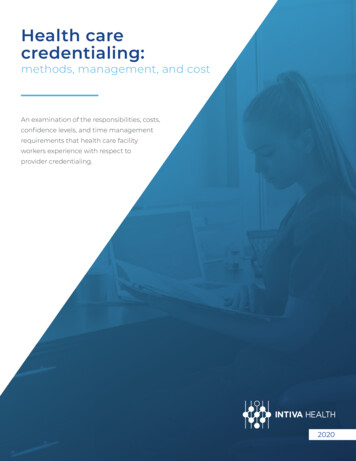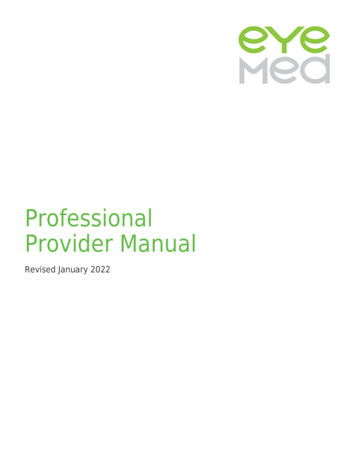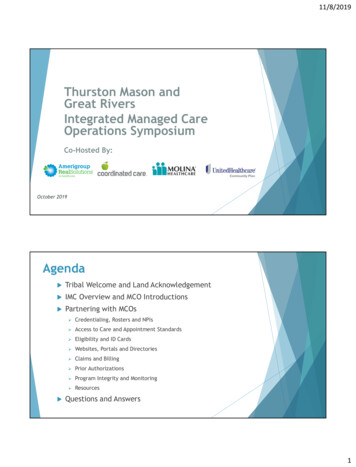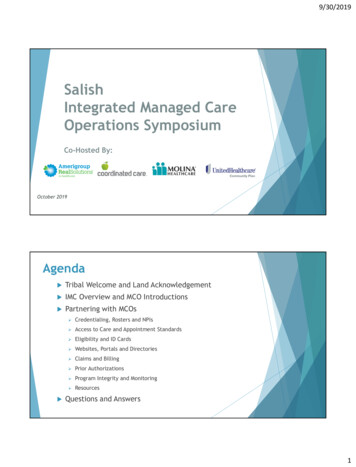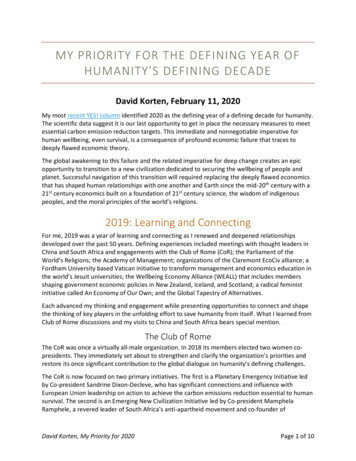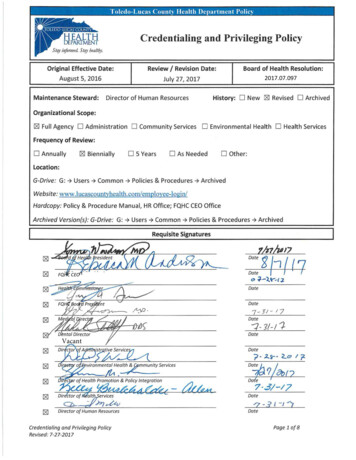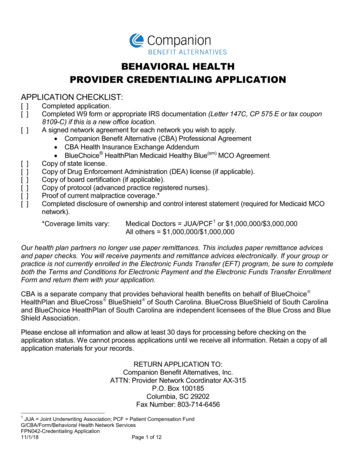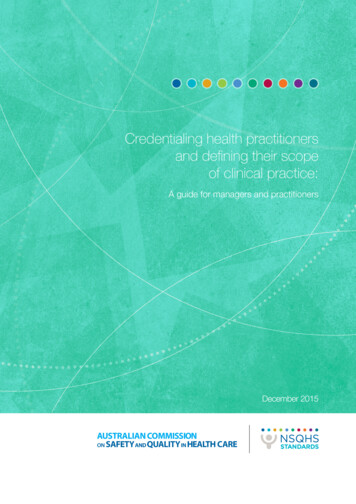
Transcription
Credentialing health practitionersand defining their scopeof clinical practice:A guide for managers and practitionersDecember 2015AUSTRALIAN COMMISSIONON SAFETY AND QUALITY IN HEALTH CARE
Commonwealth of Australia 2015This work is copyright. It may be reproduced in whole or in part for study or training purposessubject to the inclusion of an acknowledgement of the source. Requests and inquiries concerningreproduction and rights for purposes other than those indicated above requires the written permissionof the Australian Commission on Safety and Quality in Health Care, GPO Box 5480 Sydney NSW 2001or mail@safetyandquality.gov.auSuggested citationAustralian Commission on Safety and Quality in Health Care. Credentialing health practitionersand defining their scope of clinical practice: A guide for managers and practitioners.Sydney: ACSQHC, 2015.ISBNPrint:978-1-925224-25-2Electronic: 978-1-925224-24-5AcknowledgementMany individual and organisations have freely given their time, expertise and documentationin the development of this guide. The involvement and willingness of all concernedto share their experience and expertise is greatly appreciated.
ch8Part 1:Evidence of minimum credentialsPart 2:Defining the initial scope of clinical practice13Part 3:Renewal of scope of clinical practice – at pre-determined time frames16Part 4:Scope of clinical practice – clinical supervisors and trainees18Part 5:Scope of clinical practice – monitoring compliance19Part 6:Changes to scope of clinical practice (if and when required)20Part 7:Multi-facility scope of clinical practice and mutual recognition of credentials23Part 8:The credentialing committee249Additional considerations26Definitions and acronyms26Scope of clinical practice checklist28Resources34References38Credentialing health practitioners and defining their scope of clinical practice: A guide for managers and practitioners3
PurposeSafe health care is a goal of all health practitioners and an expectationof the public. To achieve this, health service organisations needto have a system in place to confirm a health practitioner’s credentialsand regularly review their scope of clinical practice. This protects bothconsumers and the treating health practitioners. Health serviceorganisations are required to appoint health practitioners who aresuitably experienced, trained and qualified to practise in a competentand ethical manner in accordance with service needs andorganisational capability.4Australian Commission on Safety and Quality in Health CareThe purpose of thisdocument is to providepractical guidancefor managers andpractitioners responsiblefor credentialing,and for determiningand managing, a healthpractitioner’s scopeof clinical practice.This is an ancillary guideonly. It does not replaceor supersede state,territory or organisationalpolicies on credentialing.
BackgroundNational Safety and Quality Health Service (NSQHS)Standard 1: Governance for Safety and Qualityin Health Service Organisations requires health serviceorganisations to ‘implement a system that determinesand regularly reviews the roles, responsibilities,accountabilities and scope of clinical practicefor the clinical workforce’ (Actions 1.10.1–1.10.5).To meet the requirements of Item 10, organisations needto provide evidence, where it is appropriate, of: recruitment processes, which, for all healthpractitioners, involve matching skills, experienceand qualifications to the role and responsibilitiesof each position formal credentialing of health practitionersundertaking unsupervised practice, suchas doctors, nurse practitioners, midwivesand allied health practitioners determining the scope of clinical practiceof health practitioners reviews of scope of clinical practiceas part of re-credentialing processes managing changes in scopeof clinical practice regular clinical supervision clinical documentation auditing performance reviews peer reviews performance development.This guide has been developed to assist managersand practitioners to establish effective processes forthe credentialing of health practitioners and determineand manage their scope of clinical practice.Credentialing and scope of clinical practice processesare key elements in ensuring the safety of consumersin health service organisations. The objectiveis to ensure that only health practitioners who aresuitably experienced, trained and qualified to practisein a competent and ethical manner can practice in healthservice organisations. A practitioner’s scope of clinicalpractice is based on the individual practitioner’s skills,knowledge, performance and professional suitabilityin keeping with the needs and service capabilityof the organisation.When health practitioners commence work in anorganisation, they are usually provided with orientation,support, and where appropriate, mentoring andsupervision for a period of time. As health practitionersgain experience, their need for support and supervisiondecreases and with experience and increased skill levelsthey exercise independent professional judgement.Similarly, over time, organisational needs and capabilitiescan change and technologies progress and new servicesmay be proposed. These factors underpin the needto routinely review and renew a health practitioner’sscope of clinical practice.Verifying credentials and defining scope of clinicalpractice are essential components of the application,recruitment and reappointment processes.The principles and processes identified in this guidecan be applied to any health practitioner wherecredentialing processes are required by a jurisdictionor health service organisation.The role of executive managers and organisationalleaders is to provide resources and a frameworkto support those clinical managers and practitionerswho coordinate and credential health practitioners anddetermine their scope of clinical practice.It is the role of executive clinical managers andorganisational leaders to determine and describethe services an organisation is to provide and itscapabilities. This information is used as the frameworkfor credentialing processes.Credentialing health practitioners and defining their scope of clinical practice: A guide for managers and practitioners5
1. Document the organisation’sservice needs and capabilitiesHealth service organisations provide different typesand levels of services in a variety of settings.They manage different levels of consumer need andcomplexity of care. They have different levels ofresourcing and different technology and equipmentavailable. They have different staffing levels and skill-mixand require practitioners to have different qualifications,skills and experience that are matched to theorganisation’s capability and consumer demand.Not all services or all levels of care can or shouldbe delivered in all settings or facilities.Organisational and service needs and capabilities mustbe known (and appropriately documented) so that healthpractitioners’ skills, knowledge and qualifications canbe matched to their scope of clinical practice.Delineating the level and type of services to be providedwithin a health service is an essential component ofdetermining scope of clinical practice for a practitioner.Some examples of what an organisation might considerwhen determining the services it provides and itscapabilities include: service planning; licensingrequirements; access to technology, equipment, imagingand laboratory services; existing staffing qualifications;and skill-mix.2. Develop a framework forcredentialing, determining a healthpractitioner’s scope of clinical practice,and managing issues that may arisein maintaining an agreed scopeof clinical practiceThis involves the organisation: establishing credentialing committees(however named or constituted) with clearlydelineated terms of reference, and ensuringthat committee members understandtheir responsibilities and have the requiredknowledge and skills to fulfil their responsibilities6 providing human resource support for thepurposes of undertaking routine appointmentand re-appointment processes such as issuingappointment letters (or contracts), developingor reviewing position descriptions,and conducting criminal record and workingwith children checks as required establishing mechanisms for the exchangeof information between human resources andthose with responsibility for credentialing anddetermining the scope of clinical practice,particularly when matters of concern withpractice are identified identifying positions within the organisationthat are to be the subject of formal credentialingand scope of clinical practice processes, andinforming staff in those roles of theirresponsibilities engaging the highest level of clinical leadershipto guide the credentialing processes andinforming staff responsible for determining thescope of clinical practice of their responsibilities documenting the processes for modifyinga health practitioner’s scope of clinical practice.This might be necessary if an organisationalor individual practitioner’s capabilities changeor if (for example) practice restrictions are placedon a health practitioner by a registration boardor a service is ceased informing those responsible for credentialingand determining the scope of clinical practiceof the relevant jurisdictional requirements establishing an appropriate system to reviewand validate the processes for credentialing,defining and managing scope of clinical practiceand ensuring these are diligent and effective.States, territories and many private sector providershave implemented policies to support the credentialingand determination of the scope of clinical practice basedon the Standard for credentialing and defining the scopeof clinical practice, 20041. Resources and links are listedon page 38.Australian Commission on Safety and Quality in Health Care
ScopeThe principles and processes identified in this guide havebeen developed to assist health services where: health practitioners are employed or provideunsupervised clinical care in an organisationunder any contractual, honorary or formalrelationship there is a jurisdictional or specific policyrequirement to credential and determine a scopeof clinical practice the organisation, itself, has determinedthat particular roles should be subject to theformal processes of credentialing and defining ascope of clinical practice.Formal credentialing and scope of clinical practiceprocesses may not be required for health practitioners: who are studying or training and undersupervision, where– their training program clearly identifies theirlevel of responsibility and their authorityto make decisions about their practice– they have regular supervision and performancereview as part of their training program. where the organisation considers consumersafety is adequately protected if the organisationrelies on its other recruitment and performancemanagement policies and procedures to appointand manage those practitioners. This may bethe case, for example, if the:– health practitioner practices in line withtheir registration requirements– health practitioner’s role is well definedand documented in a position description– health practitioner performs their role primarilyas a member of a clinical team and they havelimited independence– health practitioner has regular performancereviews and opportunities for feedback.These health practitioners’ roles and responsibilitiesand supervision arrangements should be formallydocumented in their position description and trainingprogram. Compliance should be monitored as part of theirtraining program and performance reviews. As traineesgain experience and competency (and, for example,start performing procedures) an organisation may decidethat their scope of clinical practice should be extendedand documented in accordance with their level in theirtraining program.Health service organisations should review the relevantstate and territory policies on credentialing and definingscope of clinical practice when determining which healthpractitioner positions are to participate in the formalcredentialing processes outlined in this guide.This guide does not address: issues of service provision and organisationalcapability how an organisation should decide which of theother health professions (such as podiatrists,psychologists or social workers) should besubject to these formal processes processes for practitioners who wish to appealany credentialing or scope of clinical practicedecisions.However, these matters should be addressed in otherorganisational documentation or policies and procedures.This guide addresses the requirements for assessingand credentialing an individual health practitionerand then determining their scope of clinical practice ateither: the time they are initially appointed re-appointment, renewal of scope of clinicalpractice or if concerns arise about their scopeof clinical practice.Credentialing health practitioners and defining their scope of clinical practice: A guide for managers and practitioners7
PrinciplesThis guide recommends the following principlesbe applied by clinical managers and practitionersdetermining scope of clinical practice: Relationships between practitioners and healthservice organisations are to be based ona mutual commitment to consumer safety1. A practitioner’s scope of clinical practiceis defined by the health service organisation,and is dependent on the practitioner operatingwithin the bounds of their qualifications,education, training, current experienceand competence, and within the capabilityof the facility or service in which theyare working. Decisions are based on the demonstratedcompetence of the practitioner – that is, thequalifications obtained as a result of training bya recognised training organisation and relevantto the position, and subsequent experiencein the specific areas for which the practitionerseeks to be credentialed to perform work. Decisions take into account the capabilityof the service – that is, the availability of allrelevant support services and qualified skilledstaff to safely and appropriately provide care,and the service mix (as determined bythe health service organisation). The health service has a clearly formulatedand documented service capability statementas the basis for defining the scope of clinicalpractice of its practitioners. The scope of clinical practice of a practitionershould be known and understood acrossand within clinical teams in which the practitionerworks. The processes for credentialing and definingscope of clinical practice do not, by themselves,constitute a performance management system,although information from one process mayinform the other. There is a documented appeals process thatallows practitioners to appeal decisions aboutscope of clinical practice. The credentialing and scope of clinical practicesystems should be regularly reviewed to ensuretheir ongoing effectiveness.ApproachThis guide describes a suggested approach tocredentialing and defining scope of clinical practice.The process of defining scope of clinical practicerequires the submission and review of a rangeof supporting documents. If the originals are not suppliedor previously verified through other processes, healthservice organisations may require these documents tobe certified by a Justice of the Peace or similarrecognised certifying agent when they are submitted. Determining scope of clinical practice is theresponsibility of the health service organisationwhere the practitioner practices, and is informedby the profession and input from peers andmultidisciplinary members. In credentialing, determining and managingscope of clinical practice, all parties act withtransparency, honesty and diligence to supportprocedural fairness.8Australian Commission on Safety and Quality in Health Care
Part 1: Evidence of minimum credentialsThe health service organisationshould obtain and review evidencethat the practitioner has attainedthe minimum credentials requiredfor scope of clinical practice of theposition to be filled.Evidence of minimum credentials should be collectedas part of any recruitment process and reconsideredwhen there is a change in circumstances or a changeof role for practitioners. Health service organisationsshould verify the information submitted by or on behalfof a health practitioner for the purposes of determiningscope of clinical practice, even when a recruitmentagency is used to source applicants and they undertakesome verification processes.Evidence should be collected for each of thefollowing areas.1.1 Education, qualificationsand formal trainingThe minimum required evidence of the level of educationattained includes: formal qualifications accepted for registrationby the relevant national board details of recognised postgraduate awards,fellowships and certificates that demonstratesuccessful completion of training from a relevantcollege, association or training institution.For newly graduated practitioners, evidencemay also include: a description of the competencies and learningobjectives of any training programs information on the supervised units that werecompleted from the relevant college, associationor training institution.For recognition as an advanced practitioner,additional evidence may be required – such as higherdegrees or diplomas and certificates from accreditedtraining programs in specific clinical skills and/oradvanced practices.For international graduates, additional evidence mustbe provided. This may include evidence that thequalification or training has been assessed as equivalentor the applicant has been assessed as competent by anappropriate Australian body – for example, a nationalboard, professional college, accreditation authorityor other assessing authority.1.2 Evidence of previous experienceThe minimum required evidence of previousexperience includes: evidence of relevant clinical activity andexperience in similar settings in which the scopeof clinical practice is being sought. The evidenceshould include information on the clinicalworkload and clinical complexity in that setting.If information has not been specificallyrequested, as part of the application, it maybe found in the applicant’s curriculum vitae,references, log books, or reports on supervisedclinical attachments evidence of recent practice, at an appropriatelevel that demonstrates the scope of clinicalpractice being sought. The evidence of recentpractice should be from a recognised facilityor a facility deemed relevant by the clinicaldirector or the credentialing committee.National boards have registration standards, codesand guidelines for each profession, including Recencyof practice standards2, which set requirements forregistration and renewal of registration and mayprovide guidance.If a practitioner has spent an extended period awayfrom the designated area of practice, for example,Credentialing health practitioners and defining their scope of clinical practice: A guide for managers and practitioners9
greater than 12 months, then a more rigorousassessment of their current credentials shouldbe undertaken. Before determining if practice hasbeen sufficiently recent, or if an additional support,supervision or retraining is required, considerationshould be given to factors such as: extent and period of prior practice current competencies complexity of the tasks now required and skilllevel needed, along with an assessment of skillsthat may have been lost during the gapin practice new developments in clinical practice during theperiod away from practice any continuing professional developmentundertaken by the health practitioner during theperiod away from the designated area ofpractice.For international graduates with limited experienceof the Australian health system, additional evidencemay be required by the credentialing committee.This should provide an understanding of the depthof their experience and the context in which thatexperience was gained, along with an understandingof the differences to the Australian setting and thepossible impact of this on clinical practices andconsumer safety. These applicants may be required tocomply with a plan to assess and/or attain equivalenceof experience in Australia, and compliance with this planmay need to be confirmed.1.3 Practitioner referencesand referee checksAt least two current references should be obtained.These can be either: written references submitted by the healthpractitioner with their application; however thecontent and authenticity of these references shouldbe verified. This could be by senior practitionersfrom the relevant area of specialist practice andprovided to the credentialing committee10 verbal references, which allow referees to bequestioned about the applicant’s competence,skills and other clinical matters. All verbalreference discussions should be documentedand signed and dated by a member of thecredentialing committee and the person whoconducted the reference check (if they aredifferent people).References should be obtained from people who haveobserved and therefore have first-hand experience of theapplicant’s work or people who have assessed clinicaldata relating to competence of the applicant. As refereechecks include discussion of clinical information andperformance, they should always be conducted bya clinical practitioner participating in the credentialingand scope of clinical practice processes, who hasrelevant clinical experience.At least one reference should be from either a: head of the specialty or equivalent at theinstitution where the applicant most recentlypracticed practitioner within or directly relevant to the fieldof practice in which the applicant will practice.Health service organisations may develop templates forreference checking to ensure the referee addresses allrelevant areas for the position being filled and the healthpractitioner’s application. This may include a requestfor the referee to comment on an applicant’s scopeand recency of practice, teamwork, communication,consumer feedback (if any) and/or any other issues thatcould affect the applicant’s performance.For practitioners working in solo or limited grouppractices, identifying appropriate referees maybe difficult. In this case, the credentialing committeemay need to: rely more heavily on documentary evidence ofrecent practice provide an interim determination institute processes to provide oversight orsupervision of the practitioner until their level ofcompetency is confirmed.Australian Commission on Safety and Quality in Health Care
Senior practitioners who head departments,direct programs or are head of a specialty may also havedifficulty providing the names of referees who meet thestated criteria. Clinical audit data, performance reports,peer review conference presentations and clinicalpublications (in reputable journals or by reputableagencies) may be given greater weight when assessingapplications from these practitioners. A reference checkfrom a senior administrator in the previous organisationcould also be sought.1.4 Continuing educationEvidence of continuing educational requirementsincludes information on: maintaining professional continuing educationstandards relevant to the applicant’s professionset by a national board for national registrationand accreditation scheme health professions,or appropriate association for others, which isverified and submitted annually continuing education that relates to a role inwhich the practitioner is engaged, and relevantto the scope of clinical practice being soughtby the health practitioner participating in mandatory trainingrequirements specified by the healthservice organisation/jurisdiction.If the evidence of continuing education is consideredby the credentialing committee to be not relevantto the scope of clinical practice being sought by thehealth practitioner, then it should be given littleor no weight when assessing applications.Any evidence of continuing education, presented by thehealth practitioner, should be documented and verifiablewith corroborating data and/or information.1.5 RegistrationA minimum requirement for appointment and continuingappointment is evidence of current registration with therelevant national board. Registered health practitionersmust practise in accordance with the National Law,and registration standards, codes and guidelines setby the relevant national board.Registration with a national board does not guaranteeor specify current competency of all practitioners acrossall areas of specialised practice for which they were initiallyqualified. Where the scope of clinical practice is focusedin a particular clinical area, the health service organisationmay need to undertake additional competency testingand/or seek other evidence that demonstrates the healthpractitioner’s competency and ability to fulfil the scopeof clinical practice that it is seeking.Some national boards require health practitionersto be endorsed by that board before practicing ata certain level – for example, nurse practitioners,midwives or podiatrists with a scheduled medicinesendorsement.Undertakings, conditions or notations imposed bythe relevant national board that place limits on the rolesand responsibilities of the practitioner may impact on thescope of clinical practice. These undertakings, conditionsand notations appear on the public register publishedon the national board web sites. Organisations shouldplace an obligation on health practitioners to declare(within a set time) any undertakings, conditionsor restrictions placed on their practices by theirregistering national board. Australian Health PractitionerRegulation Agency (AHPRA) has establisheda Practitioner Information Exchange service that canalert employers to changes in conditions on practitioners.1.6 Professional indemnity insuranceThe National Law provides that a registered healthpractitioner must not practice in their professionwithout appropriate professional indemnity insurancearrangements in force in relation to their practice.National boards have a professional indemnity insurancearrangements registration standard that will apply.A health service organisation may also require evidenceof current professional indemnity insurance. Whenprofessional indemnity insurance is required by the healthservice organisation, coverage should relate to a healthpractitioner’s scope of clinical practice and be consistentwith organisational policy requirements. When requiredCredentialing health practitioners and defining their scope of clinical practice: A guide for managers and practitioners11
by the organisation, evidence of coverage should beprovided annually.Health practitioners should be informed of indemnitycoverage provided by the health service organisation,if available, and its terms, conditions and limitations– for example, if insurance coverage extends to coronialinvestigations or notifications under the National Law.1.7 Other documentation andpre-employment checksThe following additional documentation maybe required as part of the initial application process: a current curriculum vitae an applicant’s declaration– covering matters such as a declaration thatthe applicant has no registrationboard restrictions or conditions on theirregistration, no criminal history, no report ofprofessional misconduct against them, noreport of unsatisfactory professional conduct,or no outstanding complaints– including permission to contact previousfacilities or organisations where thepractitioner has been employed proof of identity (this should includedocumentation to complete a 100-pointidentity check) for overseas trained practitioners,passport and copies of relevant visas.The applicant may need to provide separate corroboratinginformation if unexplained gaps in service are identifiedin the curriculum vitae.12Where the organisation does not conduct certainchecks, applicants may need to provide thefollowing information as part of the credentialingor employment/appointment process: a police check (which may includean international police check) a working with children check if thepractitioner will work with childrenFor new applicants, a web search of the applicant mayidentify matters that may impact on their capacity orcompetence to fulfil the position. The applicant shouldbe informed and afforded procedural fairness if concernsarise.1.8 International graduatesGiven the diversity of skills and experienceof internationally qualified practitioners, it is importantthat the references and checks on education, training,competencies and experience are extensive and diligent.The credentialing committee may wish to considerany additional support, supervision and/or trainingthat may be required by international practitionersto ensure their practices are safe.1.9 Peer reviewThe process for defining scope of clinical practice andcredentialing may rely on information generated frompeer review processes or confirmation that a practitionerroutinely participates in peer review processes.Peer review may be conducted as part of a routineclinical practice, as a professional activity or as partof a specifically coordinated review activity(such as 360-degree review).Further information on conducting peer review processescan be found in Review by peers: a guide for professional,clinical and administrative processes, July 2010 4.Australian Commission on Safety and Quality in Health Care
Part 2: Defining the initial scopeof clinical practiceThe health service organisationhas in place a process for definingthe initial scope of clinical practiceof the health practitioner.Defining the initial scope of clinical practice will require: the practitioner to provide evidence that theyhave the required credentials and demonstratecompetence as outlined in Part 1 the health service organisation to have in placea framework an
any credentialing or scope of clinical practice decisions. However, these matters should be addressed in other organisational documentation or policies and procedures. This guide addresses the requirements for assessing and credentialing an individual health practitioner and then determining their scope of clinical practice at either:
